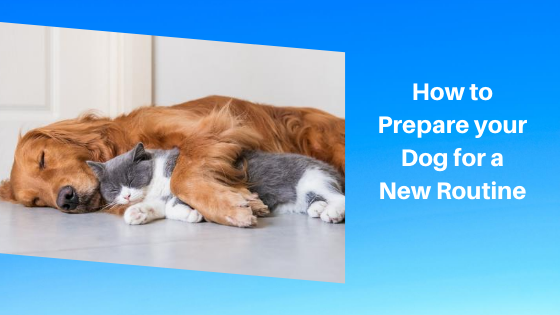How to Prepare your Dog for a New Routine
Posted by Jackie Ly on Aug 18, 2020

Nothing is certain these days, rules are changing all the time, and we don’t know how things will be in the following week, let alone month. Like humans, your dog is excellent at adapting to a familiar routine, yet they lack the awareness of their owners to understand why things are changing as often as they are. Surely your pets appreciate the extra time you have been spending with them at home, although it can’t last forever. As our lives move back to normal, you and your dog will need to adapt to a new routine.
The best way to prepare your dog for any changes in their regular program is to make a gradual transition, whenever possible. The same principles apply to any significant event in their lives, whether that’s a new training program or moving to a brand new home. Having said that, here are our best strategies to help your dog prepare for a change in their routine.
Alter your dog’s feeding window
It’s no surprise that dogs are driven by food! Your pooch learns when to expect their daily feed, so any changes to their routine may make them anxious or worried. When you are at home, it’s easy to keep a regular routine or feed them when they let you know they’re ready. When you’re at work, or out and about for whatever reason, you’ll naturally need to adjust their feeding schedule to meet your work and commute times. Try slowly changing dinner time by fifteen minutes a day, eventually settling at the same time. Set an alarm or use an automatic electronic feeder to prepare their food at the right time every day.
Introduce a fresh exercise regime
For those of us working from home, a long lunchtime walk with your dog has quite literally been a welcome breath of fresh air. Nonetheless, many of us will not be able to keep the routine up for long. While walking is a great exercise activity for you and your loved pets, not all of us can find time to get out in the early hours of the morning or the darkness of the evening.
If this is the case, think about other ways your dog can get their heart rate up. If you have a backyard, there are no excuses to not get out there with them. A simple game of fetch can go a long way, as can running a basic obstacle course for them to master. Experiment with different interactive dog toys that keep them entertained (and exercised) when you’re not around to workout with them.
Reboot your dog’s socialisation software
It can be hard for some to leave the house after being cooped up for so long. Perhaps your dog has become acclimated to their new isolation routine, or maybe they never learnt to socialise, to begin with. It’s a good idea to go over the basics with them, reintroducing different places, people and experiences.
“Getting out for walks in new areas is a great way to socialise your pup”
Getting out for walks (if possible) is a great way to do this as you and your pup can explore new neighbourhoods and meet new friends. A trip to the dog park is a fantastic idea, just keep them close by and the visit brief until they get used to being around other playful pooches again.
Teach them that your absence isn’t a big deal
If your new routine involves extended periods away from your dog, you’ll need to remind them that your absence is not something for them to worry about:
- Slowly increase the time you leave them alone. Don’t just suddenly disappear for ten hours out of nowhere - your dog won’t understand.
- Exercise them before you leave for the day - a tired dog is a calm dog!
- Never make a fuss when you leave or return home. The more your dog associates your presence with heightened emotions, the more attached they’ll be.
Read more about the best techniques to make leaving your dog home alone a breeze here.
Use a quality dog training collar
Often changes in routine can heighten your dog’s senses and provoke unwanted behaviour such as excessive barking, biting and even aggressiveness towards you or other pups. Dog training collars use mild stimuli, such as a high-pitched sound, vibration or mild-static to discourage unwanted barking and reinforce good behaviour.
You can switch your dog’s training collar on when you head out for the day or take them out for a walk to the dog park. Over time, your dog will learn what you expect from them and the behaviour you find acceptable as their owner. The greater understanding you have of one another increases the chances of a happy and well-behaved pup.
A quality, well-calibrated dog training e-collar is an excellent and safe tool that can ensure living and connecting with your dog remains a stress-free experience throughout their entire life. Dog Gear offers trusted electronic dog training collars, utilising warning tones to prompt your pup safely. With free Australian shipping and same-day dispatch, our products will be with you fast. Follow us on Facebook for the latest advice, updates and dog training tips!
